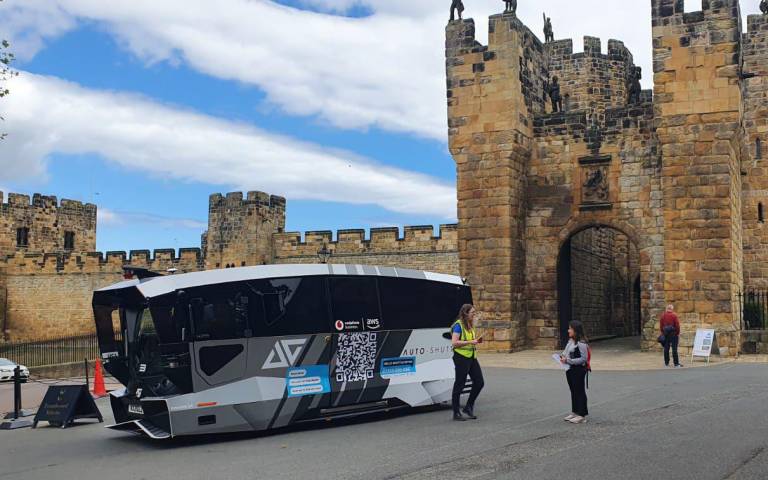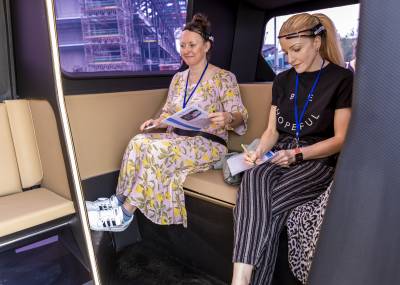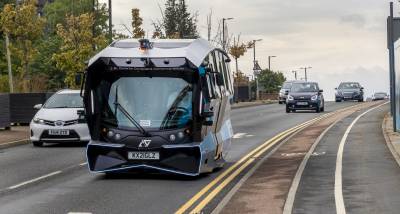The Great Self Driving Exploration
7 September 2022
UCL Energy Institute research group UCL MaaSLab record real time passenger emotions on self-driving vehicle rides in a new project funded by the Department of Transport.

How does it feel to ride autonomously? Lack of trust and hesitation might often be the case for riders to confront a ride on a self-driving vehicle, but can potential benefits turn the tables? Or is it simply the opportunity to embrace a self-driving exploration which will shape the future of driving?
The project
Commissioned by the Department of Transport (DfT), UCL MaaSLab, a research group based at the Energy Institute, formed a consortium with BritainThinks and Aurrigo to deliver on the Government’s vision for a leading-edge transport system which is underpinned by technological innovation. The DfT funded “Great Self Driving Exploration” project aims to explore how we currently travel, how we could travel in future, and understand how self-driving vehicles could help to meet those travel needs.
Through this project, UCL MaaSLab work collaboratively to expose people to self-driving vehicles in the most realistic way: participants are introduced to this cutting-edge technology and are invited to ride on a self-driving shuttle and a self-driving pod. Throughout their experience, UCL MaaSLab documents their emotions, feelings, and views through unique technologies in the field to better understand acceptance and potential adoption. In addition, rigorous educational materials are being developed using behavioural principles, and robust cognitive testing groups and deliberative dialogues are accompanying these trials to raise awareness and improve understanding of this new mobility technology.
The technology
UCL MaaSLab uses non-invasive, light weight EEG (electroencephalography) headsets which translate brain activity during trials into emotional responses. EEG readings indicate whether the passengers feel engagement, excitement, focus, interest, stress, and relaxation. By using this technology, the team demonstrate how EEG headsets can be used in understanding human behaviour through the recording and further analysis of emotional status. Since data is collected frequently, usually microseconds, the breadth of observations reaches 250,000 per individual for a 30-minute recording. This means that emotional signals can be recorded with immense granularity and be linked with events that are happening in real time while the vehicle is on the move.

Image 1: Participants wearing the EEG headsets on board the self-driving auto shuttle demonstration in Manchester
The demonstrations
The EEG data collection takes place in three different locations across the UK; Alnwick, Manchester and Taunton, covering a wide geographical spectrum and demographics. The importance of this approach is that the team are able to identify whether there are any differences in responses from passengers residing in rural areas, towns or cities as well as across a range of socio-economic factors.
The first demonstration took place in Alnwick, on the 21st June while and the second, in Manchester, on the 23rd July. The third will take place in Taunton on the 24th of September.

Image 2: The self-driving auto shuttle in real life conditions demonstration in Manchester
During these workshops, a group of 30-40 participants were invited to wear an EEG headset while riding on a self-driving vehicle. The participants rode both an Aurrigo Auto-Shuttle (a 10-seat autonomous self-driving passenger vehicle) and later an Aurrigo Auto-Pod (a four-seat self-driving pod).
The research team asks participants to complete pre and post ride surveys to self-report on their emotional state, in addition to observing their emotional status during the trial experience using the EEG data; this allows analysis and understanding of any differences between reported and observed emotional reactions to the experience. This evidence will be paired with further information on levels of acceptance of self-driving vehicles, the willingness to ride, as well as broader attitudes towards this technology. The demonstrations took place in a real-world open-road environment which further stimulates the emotional response regarding events happening in real time, as well as other psycho-physiological and behavioural changes.

Image 3: Minister of State for Transport, Trudy Harrison visits Alnwick demonstration and gets introduced to the EEG technology by MaaSLab
As an indicated support from the DfT, at the first workshop our team demonstrated the EEG technology and discussed its possibilities for research in transport and self-driving vehicles to Trudy Harrison, the Minister of State for Transport.
About UCL MaaSLab
MaaSLab’s team is comprised of Professor and Head of MaaSLab Dr Maria Kamargianni, Lecturer Dr Manos Chaniotakis, Researcher Dr Fredrik Monsuur and Research & Business Manager Dr Georgia Kouta.
Header image: The self-driving auto shuttle in Alnwick Castle
 Close
Close

